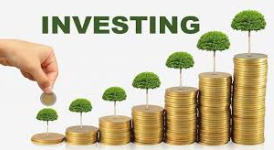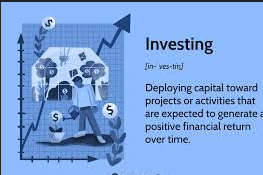Introduction to 2025 Investment Landscape
As 2025 unfolds, the investment environment in the United States continues to evolve, offering fresh possibilities across a variety of sectors. Investors are increasingly drawn to industries shaped by technological advancements, shifting societal trends, and growing global challenges. These changes are creating new pathways for individuals and organizations seeking opportunities for growth.
Key economic and societal shifts are influencing where and how capital is deployed. From the rise of innovative industries to the expansion of existing markets, investment options are becoming increasingly diverse. Additionally, the ongoing integration of advanced technology into traditional sectors is transforming the way businesses operate, opening the door for forward-thinking investors to explore untapped potential.

Demographic shifts are also impacting market dynamics, influencing consumer behavior and creating demand for new types of products and services. Factors like urbanization, remote work, and lifestyle changes are encouraging investors to pay close attention to how these trends reshape the economy and guide investment decisions.
With heightened global interest in sustainability and technological progress, sectors that emphasize eco-friendly solutions, digital infrastructure, and health innovations are at the forefront of change. Investors who recognize these trends and position themselves strategically are likely to discover substantial opportunities in areas that address emerging needs and future challenges.
Emerging Technologies
Technological innovation continues to reshape industries, creating exciting possibilities for investors in 2025. Artificial intelligence (AI) remains a transformative force, driving advancements in areas such as predictive analytics, natural language processing, and autonomous systems. These innovations are enabling businesses to streamline operations, optimize decision-making, and deliver personalized customer experiences, making AI-driven solutions a compelling focus for investment.
Another area gaining traction is robotics, which is revolutionizing manufacturing, healthcare, and service industries. Robots designed for precision and efficiency are improving production processes and reducing costs, while their integration into healthcare offers new ways to assist with surgeries, diagnostics, and patient care. With ongoing breakthroughs, robotics offers a strong foundation for long-term growth.
The expansion of quantum computing is another significant development. As research continues to unlock its potential, quantum technology is expected to address complex computational problems at unprecedented speeds. From optimizing supply chains to accelerating drug development, quantum computing has the potential to disrupt traditional methods across multiple sectors.

In addition, advancements in augmented reality (AR) and virtual reality (VR) are paving the way for new applications beyond gaming and entertainment. These technologies are finding applications in education, training, retail, and remote collaboration, offering companies innovative ways to engage customers and employees. As the hardware becomes more affordable and the software more sophisticated, AR and VR are opening doors to lucrative opportunities.
Blockchain technology is also continuing to evolve, with applications extending beyond cryptocurrency. Its ability to provide secure, transparent, and tamper-proof records is driving adoption across industries like supply chain management, finance, and healthcare. Businesses are leveraging blockchain to improve efficiency, traceability, and trust, presenting investors with opportunities to support its expansion into new areas.
Finally, 5G networks are playing a critical role in enabling these technologies to thrive. With faster data speeds and reduced latency, 5G is facilitating the growth of connected devices and powering advancements in the Internet of Things (IoT). Industries ranging from transportation to agriculture are integrating IoT solutions to improve monitoring, control, and resource management, further expanding the potential for investment in this field.
Real Estate Market Trends
The real estate market in 2025 reflects ongoing shifts in living preferences and societal needs, shaping new investment possibilities. Urban centers remain a hub for opportunities as infrastructure projects and modernization efforts continue to accommodate increasing population demands. The demand for mixed-use developments, combining residential, retail, and office spaces, is particularly noteworthy, as city dwellers seek convenience and accessibility in their everyday lives.
At the same time, suburban areas are experiencing notable growth driven by the flexibility offered by remote work arrangements. Many individuals and families are prioritizing larger living spaces and improved access to outdoor amenities, which has led to heightened interest in suburban housing developments. This trend is also influencing the need for enhanced infrastructure, such as schools, healthcare facilities, and transportation networks, to support expanding communities.

Industrial real estate is emerging as another compelling focus area, driven by the rise of e-commerce and shifts in supply chain logistics. The demand for strategically located warehouses and distribution centers is growing, as businesses aim to enhance delivery times and streamline operations. Investors are increasingly drawn to these properties due to their potential for stable income and long-term value.
In the hospitality sector, the evolving travel landscape is impacting real estate opportunities. With tourism rebounding and the preferences of travelers shifting toward unique and experiential stays, there is renewed interest in boutique hotels and vacation rental properties. Investors who can adapt to these changing preferences are well-positioned to benefit from the growing demand.
Additionally, sustainability is becoming a more significant factor in real estate investments. Environmentally conscious building practices and energy-efficient properties are gaining traction, as both tenants and buyers place greater value on sustainability. Green certifications and eco-friendly features are not only helping properties stand out in the market but are also appealing to investors seeking to align their portfolios with environmental trends.
Healthcare Innovations
The healthcare sector is undergoing remarkable advancements driven by the integration of cutting-edge technology and innovative research, paving the way for new opportunities. One prominent area of development is artificial intelligence (AI) in healthcare, which is being used to enhance diagnostics, optimize treatment plans, and streamline administrative processes. From AI-driven imaging tools capable of detecting diseases in their earliest stages to algorithms designed to predict patient outcomes, these technologies are reshaping how care is delivered.
Another transformative area is precision medicine, which focuses on tailoring medical treatments to individual patients based on their genetic makeup, lifestyle, and environment. This approach is leading to the development of targeted therapies that offer improved effectiveness and reduced side effects compared to traditional treatments. Pharmaceutical companies and biotech firms are heavily investing in this field, making it a compelling space for investors seeking long-term growth.
Gene editing technologies, such as CRISPR, are also making headlines for their potential to treat and possibly cure genetic disorders. By precisely modifying specific sections of DNA, researchers are working on groundbreaking therapies for conditions that were previously deemed untreatable. This progress is opening doors for investment in biotech companies pushing the boundaries of genetic research.
In addition, the increased focus on wearable health technology is driving demand for devices that monitor vital signs, track physical activity, and detect potential health issues in real time. These tools are empowering individuals to take a proactive approach to managing their health, while also enabling healthcare providers to gather valuable data for improved patient care. The rise of wearables is creating investment opportunities in both device manufacturers and the data analytics companies supporting this ecosystem.

Another significant trend is the development of advanced medical devices and robotics. Technologies such as robotic surgical systems and automated rehabilitation tools are improving the accuracy of procedures and enhancing patient recovery. These innovations are finding applications across a wide range of specialties, from orthopedics to cardiology, further solidifying their role in modern healthcare.
Regenerative medicine is also gaining traction, with research focused on therapies like stem cell treatments and tissue engineering. These approaches hold promise for addressing chronic conditions, repairing damaged tissues, and even regenerating entire organs. As these techniques progress from research to clinical application, they represent a growing area of interest for investors looking to support transformative healthcare solutions.
Renewable Energy Sector
The renewable energy sector in 2025 is experiencing rapid growth, driven by technological progress and an increasing global focus on reducing carbon emissions. Solar power remains at the forefront, with innovations in photovoltaic technology boosting energy production efficiency. Solar panel installations are becoming more cost-effective, making them accessible to a broader range of consumers and businesses. Utility-scale solar farms are also expanding, offering reliable energy solutions to meet growing electricity demands.
Wind energy is another critical component of the renewable energy landscape, with advancements in turbine design leading to higher energy outputs. Offshore wind projects, in particular, are gaining traction as developers harness stronger and more consistent wind patterns over the ocean. These installations are being supported by improvements in grid integration technology, which ensures stable power delivery to households and industries.
Battery storage systems are playing a pivotal role in enabling renewable energy sources to overcome challenges related to intermittency. Energy storage solutions, including lithium-ion batteries and emerging alternatives like solid-state batteries, are making it possible to store excess energy generated during peak production periods for use during lower output times. These innovations are fostering more consistent and reliable renewable energy supplies.
Additionally, the development of green hydrogen is contributing to diversification within the renewable energy sector. Green hydrogen, produced through electrolysis powered by renewable energy, is emerging as a clean alternative to traditional fuels. This technology is particularly promising for applications in heavy industry, shipping, and transportation, where reducing carbon emissions has proven more challenging.

In urban areas, microgrid systems are transforming how energy is managed. These localized grids, which can operate independently or in conjunction with larger power networks, are being used to integrate renewable energy sources more effectively. By improving resilience and reducing reliance on traditional power plants, microgrids are helping cities move closer to achieving sustainability goals.
Efforts to modernize energy infrastructure are also creating opportunities for investment. Upgrades to transmission and distribution networks are critical for supporting the widespread adoption of renewable energy, ensuring that electricity generated from renewable sources reaches end-users efficiently. Smart grid technologies, which incorporate real-time monitoring and data analytics, are being implemented to enhance system performance and reduce energy losses.
As the renewable energy sector continues to advance, its integration into diverse industries and everyday life underscores the growing importance of clean energy solutions in meeting the energy needs of the future.
The Role of Cryptocurrency
Cryptocurrency is becoming an increasingly prominent area for investors seeking diversification and potential high returns in 2025. With the growing acceptance of digital currencies across various industries, the ecosystem continues to expand, presenting both opportunities and challenges. Businesses are incorporating cryptocurrencies into their operations, using blockchain technology for secure transactions and exploring decentralized finance (DeFi) applications to improve accessibility and efficiency in financial services.
Stablecoins, designed to minimize price volatility by pegging their value to fiat currencies or other assets, are gaining traction as a practical solution for everyday transactions and cross-border payments. These digital assets provide a bridge between traditional financial systems and blockchain technology, making them appealing to individuals and organizations alike.
Non-fungible tokens (NFTs) remain a noteworthy development, enabling digital ownership of assets ranging from art and collectibles to real estate and virtual goods. As NFTs evolve, their applications are expanding into areas like licensing, ticketing, and intellectual property, creating new avenues for monetization and investment. The NFT market’s ability to connect creators directly with buyers adds another layer of appeal, fostering innovation within creative and business sectors.

Decentralized autonomous organizations (DAOs) are also gaining momentum, reshaping how communities and businesses organize and make decisions. By leveraging smart contracts, DAOs offer transparency and inclusivity, making them an attractive model for collaborative projects and ventures. Investors interested in these emerging governance structures can explore opportunities to support early-stage DAOs with unique value propositions.
The cryptocurrency mining landscape is shifting, driven by advancements in energy-efficient mining practices and the adoption of renewable energy sources. As environmental concerns take center stage, companies that prioritize sustainable mining methods are standing out, offering ethical investment options within the crypto space.
Regulation remains a key factor influencing the growth and stability of cryptocurrencies. Governments and regulatory bodies are working to establish clearer frameworks for digital assets, aiming to enhance security and reduce risks associated with fraud or misuse. While this regulatory evolution introduces uncertainty, it also signifies a maturing market, creating opportunities for investors to engage with compliant platforms and projects.
For those looking to participate in the cryptocurrency sector, understanding the underlying technology and market trends is essential. By adopting a cautious yet informed approach, investors can identify high-potential opportunities while navigating the risks inherent to this dynamic and rapidly evolving space.
